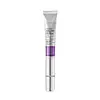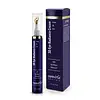What's inside
What's inside
 Key Ingredients
Key Ingredients

 Benefits
Benefits

 Concerns
Concerns

 Ingredients Side-by-side
Ingredients Side-by-side

Water
Skin ConditioningHydrogenated Poly(C6-14 Olefin)
EmollientGlycerin
HumectantPropanediol
Solvent1,2-Hexanediol
Skin ConditioningCollagen Extract
Skin ConditioningC13-15 Alkane
SolventDimethicone/Vinyl Dimethicone Crosspolymer
Skin ConditioningNiacinamide
SmoothingDicaprylyl Ether
EmollientTocopherol
AntioxidantMethyl Trimethicone
Skin ConditioningLimnanthes Alba Seed Oil
Skin ConditioningCandida Bombicola/Glucose/Methyl Rapeseedate Ferment
AntimicrobialOryza Sativa Germ Oil
EmollientCocos Nucifera Oil
MaskingOlea Europaea Fruit Oil
MaskingCetyl Alcohol
EmollientPolyglyceryl-2 Stearate
EmulsifyingGlyceryl Stearate
EmollientStearyl Alcohol
EmollientPolyacrylate-13
Polyisobutene
Polysorbate 20
EmulsifyingSorbitan Isostearate
EmulsifyingButylene Glycol
HumectantPolyglyceryl-10 Laurate
Skin ConditioningEthylhexylglycerin
Skin ConditioningTripeptide-1
Skin ConditioningPalmitoyl Pentapeptide-4
Skin ConditioningHexapeptide-11
Skin ConditioningAlanine/Histidine/Lysine Polypeptide Copper Hcl
Skin ConditioningHexapeptide-9
Skin ConditioningPalmitoyl Tripeptide-1
Skin ConditioningCopper Tripeptide-1
Skin ConditioningAcetyl Hexapeptide-8
HumectantNonapeptide-1
Skin ConditioningButyrospermum Parkii Butter
Skin ConditioningCetearyl Olivate
Sorbitan Olivate
EmulsifyingPolyglyceryl-10 Myristate
Skin ConditioningPhytosteryl/Isostearyl/Cetyl/Stearyl/Behenyl Dimer Dilinoleate
Skin ConditioningHydrogenated Lecithin
EmulsifyingFicus Carica Fruit Extract
HumectantCentella Asiatica Extract
CleansingCeramide NP
Skin ConditioningSodium Stearoyl Glutamate
CleansingParfum
MaskingTocopheryl Acetate
AntioxidantXanthan Gum
EmulsifyingAdenosine
Skin ConditioningDisodium EDTA
Bakuchiol
AntimicrobialHydrolyzed Elastin
EmollientLeuconostoc/Radish Root Ferment Filtrate
AntimicrobialSilica
AbrasiveHydrolyzed Hyaluronic Acid
HumectantSodium Hyaluronate
HumectantMadecassic Acid
Skin ConditioningMadecassoside
AntioxidantAsiatic Acid
Skin ConditioningAsiaticoside
AntioxidantPropolis Extract
Skin ConditioningWater, Hydrogenated Poly(C6-14 Olefin), Glycerin, Propanediol, 1,2-Hexanediol, Collagen Extract, C13-15 Alkane, Dimethicone/Vinyl Dimethicone Crosspolymer, Niacinamide, Dicaprylyl Ether, Tocopherol, Methyl Trimethicone, Limnanthes Alba Seed Oil, Candida Bombicola/Glucose/Methyl Rapeseedate Ferment, Oryza Sativa Germ Oil, Cocos Nucifera Oil, Olea Europaea Fruit Oil, Cetyl Alcohol, Polyglyceryl-2 Stearate, Glyceryl Stearate, Stearyl Alcohol, Polyacrylate-13, Polyisobutene, Polysorbate 20, Sorbitan Isostearate, Butylene Glycol, Polyglyceryl-10 Laurate, Ethylhexylglycerin, Tripeptide-1, Palmitoyl Pentapeptide-4, Hexapeptide-11, Alanine/Histidine/Lysine Polypeptide Copper Hcl, Hexapeptide-9, Palmitoyl Tripeptide-1, Copper Tripeptide-1, Acetyl Hexapeptide-8, Nonapeptide-1, Butyrospermum Parkii Butter, Cetearyl Olivate, Sorbitan Olivate, Polyglyceryl-10 Myristate, Phytosteryl/Isostearyl/Cetyl/Stearyl/Behenyl Dimer Dilinoleate, Hydrogenated Lecithin, Ficus Carica Fruit Extract, Centella Asiatica Extract, Ceramide NP, Sodium Stearoyl Glutamate, Parfum, Tocopheryl Acetate, Xanthan Gum, Adenosine, Disodium EDTA, Bakuchiol, Hydrolyzed Elastin, Leuconostoc/Radish Root Ferment Filtrate, Silica, Hydrolyzed Hyaluronic Acid, Sodium Hyaluronate, Madecassic Acid, Madecassoside, Asiatic Acid, Asiaticoside, Propolis Extract
Water
Skin ConditioningGlycerin
HumectantCetyl Ethylhexanoate
EmollientCyclopentasiloxane
EmollientCetyl Esters
EmollientPEG-100 Stearate
Glyceryl Stearate
EmollientC12-15 Alkyl Benzoate
AntimicrobialOctyldodecanol
EmollientButylene Glycol
HumectantPolyacrylate-13
Alpha-Arbutin
AntioxidantPalmitoyl Tripeptide-1
Skin ConditioningPalmitoyl Tetrapeptide-7
Skin ConditioningCeramide Ng
Skin ConditioningSodium Hyaluronate
HumectantAlbizia Julibrissin Bark Extract
MaskingCynanchum Atratum Extract
Skin ConditioningCardiospermum Halicacabum Flower/Leaf/Vine Extract
Skin ConditioningDarutoside
Skin ConditioningLeuconostoc/Radish Root Ferment Filtrate
AntimicrobialRibes Nigrum Seed Oil
EmollientRosmarinus Officinalis Leaf Extract
AntimicrobialHelianthus Annuus Seed Oil Unsaponifiables
EmollientHelianthus Annuus Seed Oil
EmollientPhospholipids
Skin ConditioningTocopherol
AntioxidantTocopheryl Acetate
AntioxidantUbiquinone
AntioxidantAlanyl Glutamine
HumectantCaprylic/Capric Triglyceride
MaskingBisabolol
MaskingTribehenin
EmollientPEG-10 Phytosterol
EmulsifyingDimethicone Crosspolymer
Emulsion StabilisingDimethicone
EmollientLaureth-23
CleansingLaureth-4
EmulsifyingPolyisobutene
Polysorbate 20
EmulsifyingCarbomer
Emulsion StabilisingSodium Benzoate
MaskingPotassium Sorbate
PreservativeLactic Acid
BufferingDisodium EDTA
Behenyl Alcohol
EmollientSerum Albumin
HumectantSodium Chloride
MaskingWater, Glycerin, Cetyl Ethylhexanoate, Cyclopentasiloxane, Cetyl Esters, PEG-100 Stearate, Glyceryl Stearate, C12-15 Alkyl Benzoate, Octyldodecanol, Butylene Glycol, Polyacrylate-13, Alpha-Arbutin, Palmitoyl Tripeptide-1, Palmitoyl Tetrapeptide-7, Ceramide Ng, Sodium Hyaluronate, Albizia Julibrissin Bark Extract, Cynanchum Atratum Extract, Cardiospermum Halicacabum Flower/Leaf/Vine Extract, Darutoside, Leuconostoc/Radish Root Ferment Filtrate, Ribes Nigrum Seed Oil, Rosmarinus Officinalis Leaf Extract, Helianthus Annuus Seed Oil Unsaponifiables, Helianthus Annuus Seed Oil, Phospholipids, Tocopherol, Tocopheryl Acetate, Ubiquinone, Alanyl Glutamine, Caprylic/Capric Triglyceride, Bisabolol, Tribehenin, PEG-10 Phytosterol, Dimethicone Crosspolymer, Dimethicone, Laureth-23, Laureth-4, Polyisobutene, Polysorbate 20, Carbomer, Sodium Benzoate, Potassium Sorbate, Lactic Acid, Disodium EDTA, Behenyl Alcohol, Serum Albumin, Sodium Chloride
 Reviews
Reviews

Ingredients Explained
These ingredients are found in both products.
Ingredients higher up in an ingredient list are typically present in a larger amount.
Butylene Glycol (or BG) is used within cosmetic products for a few different reasons:
Overall, Butylene Glycol is a safe and well-rounded ingredient that works well with other ingredients.
Though this ingredient works well with most skin types, some people with sensitive skin may experience a reaction such as allergic rashes, closed comedones, or itchiness.
Learn more about Butylene GlycolDisodium EDTA plays a role in making products more stable by aiding other preservatives.
It is a chelating agent, meaning it neutralizes metal ions that may be found in a product.
Disodium EDTA is a salt of edetic acid and is found to be safe in cosmetic ingredients.
Learn more about Disodium EDTAGlycerin is already naturally found in your skin. It helps moisturize and protect your skin.
A study from 2016 found glycerin to be more effective as a humectant than AHAs and hyaluronic acid.
As a humectant, it helps the skin stay hydrated by pulling moisture to your skin. The low molecular weight of glycerin allows it to pull moisture into the deeper layers of your skin.
Hydrated skin improves your skin barrier; Your skin barrier helps protect against irritants and bacteria.
Glycerin has also been found to have antimicrobial and antiviral properties. Due to these properties, glycerin is often used in wound and burn treatments.
In cosmetics, glycerin is usually derived from plants such as soybean or palm. However, it can also be sourced from animals, such as tallow or animal fat.
This ingredient is organic, colorless, odorless, and non-toxic.
Glycerin is the name for this ingredient in American English. British English uses Glycerol/Glycerine.
Learn more about GlycerinGlyceryl Stearate is a mix of glycerin and stearic acid.
It is used to stabilize the mixing of water and oil ingredients. By preventing these ingredients from separating, it can help elongate shelf life. It can also help thicken the product's texture.
As an emollient, it helps soften skin and supports barrier-replenishing ingredients.
In cosmetics, Glyceryl Stearate is often made from vegetable oils or synthetically produced.
This ingredient may not be fungal-acne safe
Fun fact: The human body also creates Glyceryl Stearate naturally.
Learn more about Glyceryl StearateLeuconostoc/Radish Root Ferment Filtrate is a natural preservative. It comes from fermenting radish roots with a bacteria called leuconostoc.
Leuconostoc comes from lactic acid.
This ingredient has antimicrobial properties and helps prevent the growth of bacteria in a product.
Leuconostoc is used to make the traditional Korean side-dish, kimchi. It is also used to make sourdough bread (both incredibly yummy foods).
Learn more about Leuconostoc/Radish Root Ferment FiltratePalmitoyl Tripeptide-1 is also known as pal-GHK. It is made up of 3 amino acids and palmitic acid, a fatty acid that helps it absorb into skin more easily.
This peptide is as a signal peptide, meaning it tells the skin to produce more collagen. Collagen is the key protein that helps form the skin's structure and keep it plump, firm, and hydrated.
By boosting collagen production, this ingredient supports a stronger skin barrier and helps reduce the appearance of wrinkles.
You'll most likely see this ingredient paired with Palmitoyl Tetrapeptide-7 in the well-known Matrixyl 3000 complex. While results from in-house testing should be viewed cautiously, this peptide duo is among the most studied and widely used in modern skincare.
Due to its palmitic acid base, this ingredient may not be safe for Malassezia folliculitis.
Read more about other common types of peptides here:
Learn more about Palmitoyl Tripeptide-1Polyacrylate-13 is a type of acrylate polymer. Acrylate polymers are commonly used as adhesives in cosmetics.
Polyacrylate-13 creates a film to protect the skin. It is also used to thicken and stabilize a product. It works by making water a gel-like consistency. This gel consistency helps suspend particles.
Polyacrylate-13 is a copolymer of acrylic acid, acrylamide, sodium acrylate, sodium acryloyldimethyltaurate monomers
Learn more about Polyacrylate-13Polyisobutene is a synthetic polymer made from isobutene.
It is a film-forming agent and helps bind ingredients together.
Polyisobutene is not absorbed by the skin.
Learn more about PolyisobutenePolysorbate 20 is made by combining ethoxylation of sorbitan, ethylene oxide, and lauric acid. It is a mild cleansing agent, surfactant, and emulsifier.
As a surfactant, it helps collect dirt and oils for washing. Emulsifiers prevent oils and water from separating.
Polysorbate 20 also adds scent to a product. Since it is made using sorbitol, it has a sweet scent. Sorbitol can also be found in fruits such as apples and peaches.
The lauric acid used to create Polysorbate 20 is often derived from coconuts.
Polysorbate 20 may not be fungal acne safe.
Learn more about Polysorbate 20Sodium Hyaluronate is hyaluronic acid's salt form. It is commonly derived from the sodium salt of hyaluronic acid.
Like hyaluronic acid, it is great at holding water and acts as a humectant. This makes it a great skin hydrating ingredient.
Sodium Hyaluronate is naturally occurring in our bodies and is mostly found in eye fluid and joints.
These are some other common types of Hyaluronic Acid:
Learn more about Sodium HyaluronateTocopherol (also known as Vitamin E) is a common antioxidant used to help protect the skin from free-radicals and strengthen the skin barrier. It's also fat soluble - this means our skin is great at absorbing it.
Vitamin E also helps keep your natural skin lipids healthy. Your lipid skin barrier naturally consists of lipids, ceramides, and fatty acids. Vitamin E offers extra protection for your skin’s lipid barrier, keeping your skin healthy and nourished.
Another benefit is a bit of UV protection. Vitamin E helps reduce the damage caused by UVB rays. (It should not replace your sunscreen). Combining it with Vitamin C can decrease sunburned cells and hyperpigmentation after UV exposure.
You might have noticed Vitamin E + C often paired together. This is because it is great at stabilizing Vitamin C. Using the two together helps increase the effectiveness of both ingredients.
There are often claims that Vitamin E can reduce/prevent scarring, but these claims haven't been confirmed by scientific research.
Learn more about TocopherolTocopheryl Acetate is AKA Vitamin E. It is an antioxidant and protects your skin from free radicals. Free radicals damage the skin by breaking down collagen.
One study found using Tocopheryl Acetate with Vitamin C decreased the number of sunburned cells.
Tocopheryl Acetate is commonly found in both skincare and dietary supplements.
Learn more about Tocopheryl AcetateWater. It's the most common cosmetic ingredient of all. You'll usually see it at the top of ingredient lists, meaning that it makes up the largest part of the product.
So why is it so popular? Water most often acts as a solvent - this means that it helps dissolve other ingredients into the formulation.
You'll also recognize water as that liquid we all need to stay alive. If you see this, drink a glass of water. Stay hydrated!
Learn more about Water